November 20,1962. Thanksgiving was two days away, but 41-year-old Allen Ditson wasn’t looking forward to it. He wouldn’t spend the day gnawing on a turkey drumstick or fighting with a cousin to claim the last slice of pumpkin pie. In fact Allen wouldn’t have the classic holiday dinner at all, unless he requested it for his last meal. If Governor Brown didn’t commute his death sentence, like he had done for Allen’s pal Carlos Cisneros, he would be executed in San Quentin’s gas chamber on Thanksgiving Eve.
* * *
 In 1959 Allen owned a small jewelry and watch repair shop at 7715 Hollywood Way in the San Fernando Valley. The former Kansas farm boy was the father of two, a WWII veteran and former pilot who had spent five years in uniform before being honorably discharged. When he was mustered out of the service he took courses in watch and jewelry repair then opened his own business. He worked long hours and he continued to take classes related to his trade. The time he spent away from home was hard on his marriage; so hard in fact that he and his wife separated. Even though they no longer lived together he saw his children “at least twice a week” and contributed to their support. His mother-in-law said “he’s been good to all of us.”
In 1959 Allen owned a small jewelry and watch repair shop at 7715 Hollywood Way in the San Fernando Valley. The former Kansas farm boy was the father of two, a WWII veteran and former pilot who had spent five years in uniform before being honorably discharged. When he was mustered out of the service he took courses in watch and jewelry repair then opened his own business. He worked long hours and he continued to take classes related to his trade. The time he spent away from home was hard on his marriage; so hard in fact that he and his wife separated. Even though they no longer lived together he saw his children “at least twice a week” and contributed to their support. His mother-in-law said “he’s been good to all of us.”
On the surface Allen’s life appeared completely normal, but it wasn’t. The seemingly average businessman had a secret, he was the mastermind of a gang of violent armed robbers. Under his direction the gang of about 15 men had netted an estimated $150,000 (equivalent to approximately $1.2 in current dollars) between January and October of 1959.
Like most gang leaders Allen had a lieutenant, his name was Carlos Gonzales Cisneros. According to court records Carlos lost his mother to tuberculosis and spent most of his infancy and childhood in foundling homes. He left school in 1950 when he was 17. He married, had four kids and worked at Lockheed as a sheet metal worker. He was 24-years-old and working the swing shift as a sheet metal worker at Lockheed when he met Allen. Allen was already running a gang and he slowly brought Carlos in. He began by telling the young man that “it would be nice to see him driving a Cadillac.” Eventually Carolos owned two Cadillacs.
Allen used skills he’d learned in the military to operate the gang. He was adamant that each member carry out his “assignment” with precision. If things went sideways and a gang member was busted he was to keep his mouth shut. Allen would see to it that he was provided with an attorney. Allen also made it clear that the penalty for being a “squealer” or a blackmailer was death.
During September and October 1959 a series of robberies were committed by Allen and Carlos and several gang members: Robert Ward, Keith Slaten, and Eugene and Norman Bridgeford.. During a robbery in October Robert “Bob” Ward failed his assignment. He was supposed to securely bind the store owners. He tied the man tightly, but the woman was able to free herself. Once freed the man grabbed his rifle and began shooting at the fleeing robbers. As they ran Eugene pitched the stolen cash box into some shrubs in an alley. Later that night Eugene and Carlos returned to retrieve the cash box and were busted on the spot. About a week later they made bail. During a meeting with Allen, Carlos and Eugene were informed that Bob was demanding money in exchange for keeping quiet about the gang.
On November 6, 1959, Allen told Eugene that he had “decided that tonight would be the best night to get rid of Bob Ward” because he was “through being blackmailed by a no-good-son-of-a-bitch like him.” Allen had already paid Bob $100 but had no intention of giving him one dime more. Allen came up with a plan to “…get rid of him.” Allen stayed at the store and let Carlos and Eugene implement his plan to take care of Bob.
Carlos and Eugene drove to a liquor store to pick up a couple of pints of booze. They knew that Bob was a heavy drinker and thought that he would be “more amiable” with a few shots of booze in him. Then they went to the house Bob shared with fellow gang member Keith Slaten. Carlos parked the Cadillac on the street in front of the house. Keith had seen them pull up and went out to greet them. Keith and Bob thought they were going to pull another robbery. The men piled into Keith’s Ford. Keith was behind the wheel, Bob was in the passenger seat, and Eugene and Carlos sat in the back. They spent about 45 minutes drinking. Carlos picked up a hammer from the floor of Keith’s car and brought it down on the back of Bob’s head. Bob fell against Keith and screamed: “Keith, help me. They are trying to kill me.” Keith had his own life to worry about and gave Bob a shove so he’d be an easier target for Carlos–then he ran into the house. Carlos called him back and said, “just take it easy and it’ll be all right.”
In the interim Bob had managed to get out of the car and was leaning against a tree when Carlos found him and beat him down to the ground. Carlos backed his car into the driveway and after delivering a few more blows to Bob’s head put him in the trunk of the car. Carlos and Eugene drove off and Keith followed them in the Ford. Carlos had driven about half a mile before Bob regained consciousness and started pleading from his confinement in the trunk to be released. He said he thought his eye had come out of its socket. Carlos told him to be quiet and then turned up the car radio so he wouldn’t be able to hear Bob call his name.
Now thoroughly rattled Carlos misjudged a turn, struck the curb with the front wheel of the car and blew a tire. He spotted a pay phone, gave Eugene some change and told him to call Allen and ask him to bring a spare tire and a heavy duty jack (after all it was a Cadillac with a man in the trunk). About an hour later Allen arrived with a friend of his, Leonard York. They changed the tire and then Carlos, with Bob still in the trunk, took off for the jewelry store. Eugene and Leonard rode with Allen back to the store. When they arrived they could hear unintelligible noises coming from the trunk of the Cadillac. Allen said they’d have to get rid of Bob before the neighbors heard him and called the cops. Eugene took Leonard home and then begged off the rest of the evening saying he was sick.
Allen took a .38 revolver from the store and he and Carlos drove Bob out to the Newhall Pass. Allen opened the trunk and ordered Bob to get out. Unaided, the seriously injured man got out and stood on his feet. He asked for a cigarette. Allen shot him in the chest. He fell, got up, and ran toward Carlos. As they rolled over an embankment Allen shot Bob in the back paralyzing him. Allen walked down the incline to see if Bob was finally dead. He wasn’t. He said, “Give me another one.” Allen knelt down beside him, pressed the .38 to his head and killed him.
NEXT TIME: Which will it be for Allen Ditson? A turkey dinner with more to come, or the gas chamber?



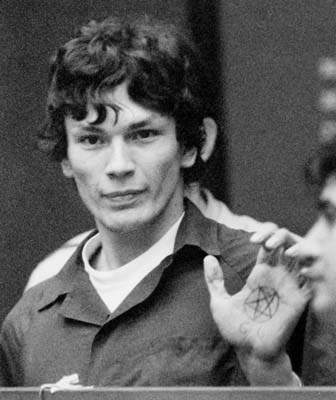
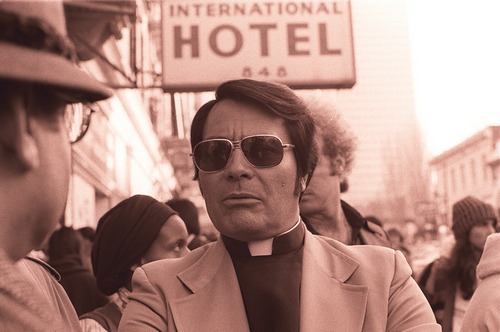
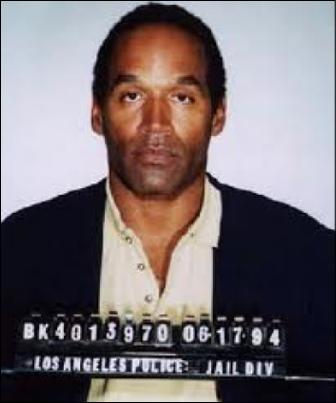 Here in L.A. there was the murder trial of O.J. Simpson, the so-called Trial of the Century. If you remove fame, wealth, and race and reduce the crime to its basic elements you end up with nothing more than a tragic domestic homicide–the type of crime which is altogether too common everywhere–yet the case continues to fascinate.
Here in L.A. there was the murder trial of O.J. Simpson, the so-called Trial of the Century. If you remove fame, wealth, and race and reduce the crime to its basic elements you end up with nothing more than a tragic domestic homicide–the type of crime which is altogether too common everywhere–yet the case continues to fascinate. Welcome! The lobby of the Deranged L.A. Crimes theater is open! Grab a bucket of popcorn, some Milk Duds and a Coke and find a seat. Tonight’s feature is ONE WAY STREET starring James Mason, Marta Toren, and Dan Duryea. Enjoy the movie!
Welcome! The lobby of the Deranged L.A. Crimes theater is open! Grab a bucket of popcorn, some Milk Duds and a Coke and find a seat. Tonight’s feature is ONE WAY STREET starring James Mason, Marta Toren, and Dan Duryea. Enjoy the movie!
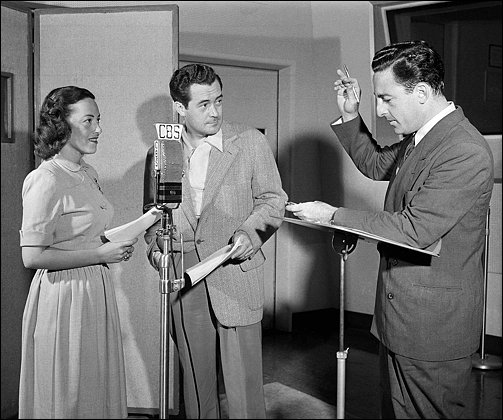


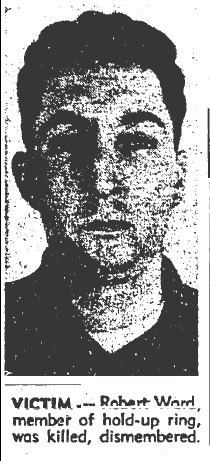 After shooting Bob Ward to death with a .38, Allen Ditson had to figure out what to do with the body. At least Carlos Cisneros was there to help him. Carlos began to dig a grave with his bare hands until Allen brought him a butcher knife from the car. Once the grave was ready Allen said that they would have to dismember Bob to prevent identification if someone should discover his remains. Using the butcher knife they removed Bob’s head and each arm at the elbow. They buried the remains and then tossed the head and arms into the truck of the car and drove back Allen’s store.
After shooting Bob Ward to death with a .38, Allen Ditson had to figure out what to do with the body. At least Carlos Cisneros was there to help him. Carlos began to dig a grave with his bare hands until Allen brought him a butcher knife from the car. Once the grave was ready Allen said that they would have to dismember Bob to prevent identification if someone should discover his remains. Using the butcher knife they removed Bob’s head and each arm at the elbow. They buried the remains and then tossed the head and arms into the truck of the car and drove back Allen’s store.
 Because Allen and Carlos were incapable of keeping quiet about what they’d done it was only a matter of time before the law caught up with them. The remaining gang members began to fear Allen more than they did the cops. On June 17, 1960 Keith Slaten went to the police and a few days later Eugene Bridgeford did the same. The statements were enough for the police to get a warrant to examine Carlos’ Cadillac–they found traces of human blood in the trunk. One day later the police conducted a similar examination of Keith’s Ford and found human blood on the upholstery. On June 28, “sometime after 1:00 p.m.” Allen and Carlos were taken into custody.
Because Allen and Carlos were incapable of keeping quiet about what they’d done it was only a matter of time before the law caught up with them. The remaining gang members began to fear Allen more than they did the cops. On June 17, 1960 Keith Slaten went to the police and a few days later Eugene Bridgeford did the same. The statements were enough for the police to get a warrant to examine Carlos’ Cadillac–they found traces of human blood in the trunk. One day later the police conducted a similar examination of Keith’s Ford and found human blood on the upholstery. On June 28, “sometime after 1:00 p.m.” Allen and Carlos were taken into custody.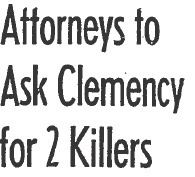
 In 1959 Allen owned a small jewelry and watch repair shop at 7715 Hollywood Way in the San Fernando Valley. The former Kansas farm boy was the father of two, a WWII veteran and former pilot who had spent five years in uniform before being honorably discharged. When he was mustered out of the service he took courses in watch and jewelry repair then opened his own business. He worked long hours and he continued to take classes related to his trade. The time he spent away from home was hard on his marriage; so hard in fact that he and his wife separated. Even though they no longer lived together he saw his children “at least twice a week” and contributed to their support. His mother-in-law said “he’s been good to all of us.”
In 1959 Allen owned a small jewelry and watch repair shop at 7715 Hollywood Way in the San Fernando Valley. The former Kansas farm boy was the father of two, a WWII veteran and former pilot who had spent five years in uniform before being honorably discharged. When he was mustered out of the service he took courses in watch and jewelry repair then opened his own business. He worked long hours and he continued to take classes related to his trade. The time he spent away from home was hard on his marriage; so hard in fact that he and his wife separated. Even though they no longer lived together he saw his children “at least twice a week” and contributed to their support. His mother-in-law said “he’s been good to all of us.” On February 3, 1925 a bizarre story broke in the local news — it was alleged that seven year old Alsa Thompson had attempted to murder a family of four with a mixture of sulphuric acid and ant paste she had added to the evening meal. The intended victims tasted the food, but it was so awful they pushed their plates away.
On February 3, 1925 a bizarre story broke in the local news — it was alleged that seven year old Alsa Thompson had attempted to murder a family of four with a mixture of sulphuric acid and ant paste she had added to the evening meal. The intended victims tasted the food, but it was so awful they pushed their plates away.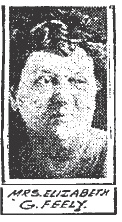 Alsa was taken by Policewoman Elizabeth Feeley to the Receiving Hospital where she was questioned by police and surgeons about the poisoning plot. The little girl cheerfully confessed that she had indeed attempted a quadruple homicide and that she’d done it because: “…I am so mean.”
Alsa was taken by Policewoman Elizabeth Feeley to the Receiving Hospital where she was questioned by police and surgeons about the poisoning plot. The little girl cheerfully confessed that she had indeed attempted a quadruple homicide and that she’d done it because: “…I am so mean.”